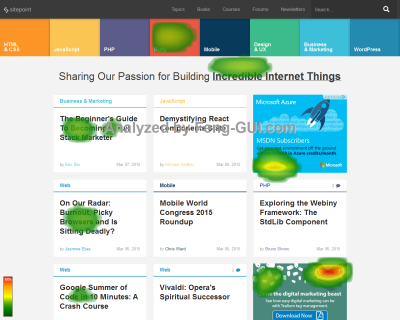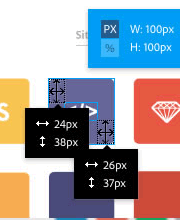Traditional site analysis tools always provide you with valuable insights into how popular your content is and the length of time users spend on your site. However even the best analysis tools are limited in the information they report.
For example, are you currently able to pinpoint what is causing high cart abandonment rates, or what portions of your copy are the most eye catching to users.
Fortunately you can use heatmap and mouse tracking tools to gain insights into the minds of your users without the expense of setting up formal focus groups. Aside from being cost effective, heatmap tools have an advantage over focus groups because the user is naturally interacting with your product, often unaware that they are being watched.

Although the benefits of these tools are fairly clear, as previously discussed on SitePoint click tracking and heatmaps provide numerous benefits however knowing how to leverage these tools to improve your website can be the difference between success or failure in your space.
Narrowing the Scope
When it comes to your heatmaps and mouse tracking, it is important to focus your efforts around key pages rather than your entire site. The primary focus of your analysis should be content designed to convert users such as an offering landing page or the checkout section for an online store.
Since many tools use recorded sessions to measure account usage, you will want to put your money towards tracking the pages with the most insights.
If you’re looking to test a blog, you should focus on the homepage since that will provide the most insights into where users are going within your site. Targeting popular blog posts also can provide valuable insights into your audience.
On the other hand, with an eCommerce store, you would want to focus your efforts around the products with the most activity, or items which are top in their categories. With general content such as company pages, you will want to focus on the homepage, portfolio, testimonial and FAQ pages.
Prioritize Your Testing
Regardless of the size of your site, it’s always important to conduct a cost benefit analysis of your tests to ensure that you aren’t putting effort towards the wrong areas of your website. When completing this stage you should assign each of the aspects below a number from zero to ten where ten is the hardest.
When choosing between pages, the ones with lowest scores should be tested first.
The key points to consider when evaluating the return on investment from testing include:
- Duration: The longer a test is, the higher the score should be.
- Ease: Unless testing something such complex such as user workflow, your tests should be as simple as possible.
- Impact: Even if a page is popular, if it isn’t generating leads or sales, it probably shouldn’t be tested. On the other hand, landing pages almost should always be tested.
- Cost: If you don’t require paid advertisement, then your cost is going to be zero. Otherwise, the more competitive your keywords are, the more difficulty you’ll have keeping your paid campaigns within a reasonable budget.
On a sidenote, while pay per click advertising can be a daunting topic, SitePoint has an article on how to make your ad copy more compelling to make your ads more relevant to your target audience.
Determining Your Ideal Sample Size
When analysing mouse tracking and heat mapping data you should ensure that your sample size is appropriate for what you are testing.
Unfortunately there isn’t a magic number as the size depends on the scope of the project. If you’re trying to obtain a precise estimate for a sample size, Wikipedia has an extensive page on the topic.
For those who are less mathematically inclined, in general, your study should have at least 100 samples.
Remember: It’s Just One of Many Tools
When gathering insights to optimize your website, it is vital to ensure that you don’t pigeon-hole yourself into only using one tool for all your needs. As effective as heatmaps and mouse tracking can be to providing insights into how users interact with your website, they are only practical when analysing relatively small segments of your site.
By using traditional analysis tools you not only gain insights from your entire website, but you also have the ability to pinpoint trouble spots based on general user engagement.
As with anything in life, unless you have context to an issue or a problem, you need to have context before trying to tackle the issue. Without outside information you can see it from a completely different perspective than the end user.
 Charles Costa
Charles CostaCharles Costa is a content strategist and product marketer based out of Silicon Valley. Feel free to learn more at CharlesCosta.net.




